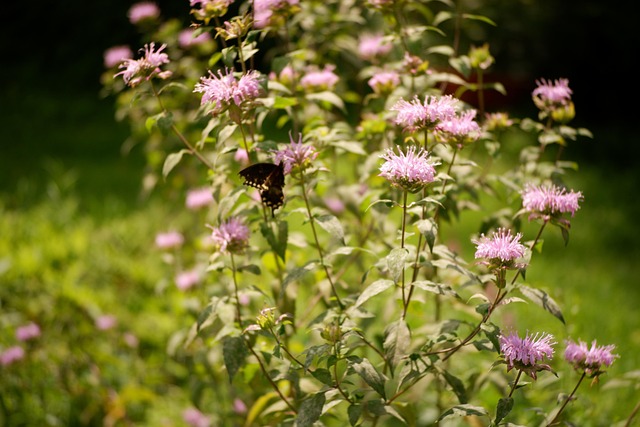
 |  |  |   |  |
 |
Monarda is a genus of annual and perennial herbaceous plants. The stem is straight, square-shaped, and branched, sometimes reaching over 1 meter in height. The rhizomes are long and spread in all directions. Leaves are elongated-lanceolate, slightly pubescent, with serrated edges. Leaves grow oppositely on short petioles, facing each other.
The flowers are small, tubular-funnel-shaped, grouped in one or several head-like inflorescences (6-7 cm in diameter), arranged one above another along the flowering stem. The flowering period lasts from late June to August, about 50 days. Flower colors vary by species and include white, pink, raspberry, red, or yellowish. The flower formula is ♀↑○Ч(5)Л(2,3)Т2,2П(2) or *Ч(5)Л(5)Т5П(2).
Fruits are very small, dry, and split into 4 nutlets. Seeds are small and mature in late August or September, depending on weather conditions. The plant’s growing season lasts almost until the onset of stable cold weather.
Harvesting raw material
The medicinal raw material of all Monarda species is the above-ground part of the plant. It is harvested at the very beginning of flowering because this period contains the highest concentration of essential oils. The cut herb is dried in the shade or in a well-ventilated area. Coarse and thick stems should be removed immediately to avoid complications in the preparation of herbal mixtures and infusions. The raw material should not be too finely crushed to prevent damage to the essential oil glands, as this causes the oil to evaporate and significantly reduces the quality of the material.
Chemical composition
All above-ground parts of Monarda contain up to 3% essential oil, mainly concentrated in the leaves and flower clusters, with only a small amount in the stems.
Monarda oil has a light yellow to reddish-brown color and a sweet balsamic-lavender scent. Its composition varies depending on the plant’s growth stage, origin, population, and species. However, the oil of any Monarda species always contains phenols (thymol, carvacrol, p-cymene), sabinene, cineole, terpinenes, limonene, and myrcene.
Pharmacological properties
Monarda has a positive effect on the gastrointestinal tract, liver, and gallbladder function, improving digestion.
A key property of Monarda is its ability to stimulate heart activity and relieve cardiac neuroses, thanks to flavonoids and vitamin C found in the leaves and flowers. Plant pigments called anthocyanins strengthen capillary walls, dilate coronary vessels of the heart, and also have a diuretic effect.
The essential oil of Monarda contains flavonoid substances with strong antiseptic and anti-inflammatory effects. This makes the oil highly effective against various disease-causing agents such as bacteria, fungi, protozoa, and others. Its activity is especially valuable against three genera of mold fungi: Aspergillus, Penicillium, and Mucor.
Monarda use helps normalize menstrual cycles in young women experiencing dysfunction.
Due to its high thymol content, fresh leaf juice promotes wound healing.
Additionally, Monarda essential oil has reproductive, anti-stress, antioxidant, and anti-anemic effects.
Monarda is also beneficial for treating flu and colds, as it not only boosts immunity but also helps combat various viruses and microorganisms.
Traditional medicine uses
Monarda ranks among the top plants for its bactericidal properties. In folk medicine, it is most commonly used as a natural antiseptic. To promote better wound healing and treat skin infections, traditional healers recommend applying compresses made from freshly squeezed Monarda juice. A tincture is used to rinse the throat and mouth for stomatitis and tonsillitis. Inhalations from Monarda leaves are effective for respiratory diseases such as bronchitis, bronchial asthma, and tracheitis.
Certain species of Monarda (Monarda didyma and Monarda punctata) were used by Native Americans for inhalations to treat colds, as a mild laxative, antimicrobial, antispasmodic for cramps and colic, and to improve local blood circulation.
Native Americans observed the antiseptic properties of Monarda: fresh leaves were used to treat wounds and skin infections, and the plant tincture was used for rinsing the throat and mouth, improving dental and gum health, relieving headaches and fevers, and as a general stimulant and carminative. Oswego tea made from Monarda leaves was also used to treat and prevent headaches and colds.
Monarda essential oil is used in traditional medicine to treat burns, eczema, and hair loss. Treatments utilize not only the pure essential oil but also infusions, juice, and poultices made from the leaves and flowers.
Cosmetic Use
Twinflower Monarda is also used in homemade cosmetics thanks to its antiseptic, toning, and anti-inflammatory properties. It is especially suitable for caring for oily, combination, and problematic skin, as well as soothing sensitive skin. Infusions and hydrolates derived from this plant help to cleanse the skin, tighten pores, and reduce irritation.
The basis of cosmetic use is Monarda water infusions, which are used as facial tonics or compresses, for example, to prevent acne, redness, or inflammation. Regular use helps balance the skin’s microflora and reduce sebaceous gland activity.
Twinflower Monarda is also suitable for hair care. The infusion strengthens the scalp, helps relieve itching and dandruff, while imparting a light, pleasant fragrance to the hair. It can be used as a rinse after washing hair or added to homemade shampoos and hair masks.
Since Monarda essential oils have antibacterial and refreshing effects, they are sometimes included in homemade deodorants or foot care products where natural cleansing and deodorizing action is needed.
For cosmetic purposes, it is recommended to use light infusions or hydrolates (flower waters), which can be prepared at home by pouring hot water over the plant and letting it steep, or by steam distilling the flowers.